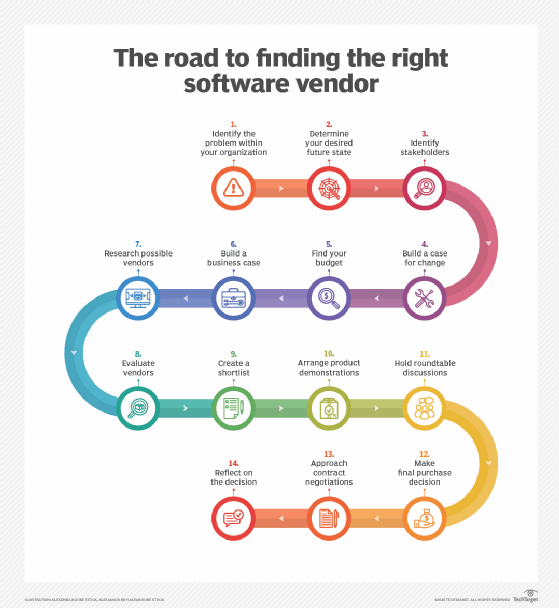Step-by-step guide to the software purchasing process
This guide to software purchasing will help you create a procurement plan for the software that best meets your business need.
Businesses of all sizes and across all industries rely on software to optimize their work processes. Too often, however, employees looking to purchase information technology products and services don't stop to think about which vendor's business software will be a good cultural fit for their organization.
That's where this step-by-step buyer's guide for the software purchase process can help.
By completing each of these steps, you'll be able to create a strong procurement plan and make an informed purchasing decision.
This outline won't leave you with any surprises -- and the knowledge you'll gain from carrying out your Due diligence during your research will continue to produce benefits long after the contract has been signed.
With that said, let's go find a vendor!

Step 1: Identify your business needs
Before you can even begin considering vendors, you must define the problem you're trying to solve as well as your specific needs. Maybe your current HR software needs an upgrade or you're looking for software with automation to streamline and digitize inefficient workflows. Or maybe you need to purchase new contact center software to provide better customer service and retention.
In many cases, the problem you're facing may be the result of both faulty processes and inadequate software. Identifying these issues is not an exercise in fault-finding. It is an opportunity to approach problems in a new way. Spend time with the affected teams to gain an understanding of the problems from their perspective and how important a resolution is.
Ask them what they like and don't like about the current software. Observe how they use the existing system and ask them to explain what changes would make their job easier.
This will help ensure your project generates a return on investment (ROI) because you're investigating systems that your end users will actually use.
This first and more important step of the entire process is to look closely at why this new software is needed. By gathering feedback and ideas, you can determine if there is a strong enough business reason to proceed with the project and invest resources.
| Action items |
|
| Questions to consider |
|
Step 2: Get stakeholder buy-in and involvement
Before you can start narrowing down software companies to review, you need to identify all your stakeholders. Be sure to consider:
- End users. The team members who will be interacting with the product daily. Make sure each department that will be affected is represented to ensure the right software is chosen.
- Subject matter experts. The people in your department or company who understand the ins and outs of the project and how it affects the company.
- Decision-makers. The critical people you need to sign off on the decision.
- IT. Most products usually require technical support from your IT group, including understanding platforms, integration points, data flow and more.
- Legal and finance. These are the people who will approve budgets and specify any legal requirements for a potential software product.
If you are a small business, you may know the names and responsibilities of each stakeholder off the top of your head. If not, you may want to consider creating a RACI matrix. RACI stands for "responsible, accountable, consulted and informed."
A RACI matrix includes:
- Responsible stakeholders. The employees are responsible for doing the work and completing the task.
- Accountable stakeholders. Those who sign off on the work and designate it as completed. If anything seems askew, they are the ones who need to answer for it.
- Consulted stakeholders. Those who are active in the loop and are asked to give input.
- Informed stakeholders. Those who are updated on progress and decisions but are not formally consulted.
A RACI matrix can help you identify who will be involved in each step of the vendor selection process. Below is an example:
| R - Responsible | A - Accountable | C - Consulted | I - Informed |
| Project activity or deliverable | C-suite | Project business owner | Project manager | Operations | IT | Employee |
| Identify the problem | I | R | C | C | C | I |
| Determine your desired future state | I | R | C | C | C | I |
| Identify stakeholders | I | R | C | I | I | I |
| Build a case for change | A | R | C | C | C | I |
| Find your budget | A | R | I | C | C | I |
| Build a business case | A | R | C | C | C | I |
| Research possible vendors | I | R | R | I | I | I |
| Evaluate vendors | I | R | C | I | I | I |
| Create a shortlist | A | R | C | C | C | I |
| Arrange demos | A | R | I | C | C | I |
| Roundtable discussion | R | R | R | R | R | I |
| Purchase decision | A | R | I | C | C | I |
| Negotiation considerations | A | R | I | I | I | I |
| Reflection | I | R | C | C | C | I |
Once you've identified all your stakeholders, choose a software buyer from each group to form a technology buying team. This committee is responsible for evaluating software vendors. They're also responsible for making sure the business' hardware can support the new technology during the software purchase process.
If you're a large company, the group can include five or more decision-makers, each with different levels of influence and varying requirements that need to be addressed.
When you start asking questions, you'll find there are stakeholders whose needs should be considered sooner, rather than later.
| Action items |
|
| Questions to consider |
|
Step 3: Determine your budget
Before submitting a purchase request or purchase order for the software buying process, examine your budget and consider whether you have enough money to support your needs. You may have to reevaluate your spending in other areas, but fitting the purchase into your own budget is the easiest option.
If you don't have enough money, then you'll have to find the funding elsewhere. Work with department heads and C-level executives to examine the projected yearly budget and gain an understanding of where your company stands financially.
Next, consider the total cost of ownership (TCO) -- including direct and indirect costs over the technology's entire lifecycle -- for the product you're looking to invest in.
Determining the direct and indirect costs of a software implementation depends on your line of business.
For example, if you work for a management consulting company and the application in question is used to produce consulting deliverables, then your purchase and deployment of project management software can reasonably be considered a direct cost.
Next, consider the licensing costs. These will likely vary greatly depending on if you want an on-premises, software as a service (SaaS) or private cloud offering. Licensing can also vary based on the number of users that need access to the software.
You'll also want to consider setup and maintenance fees. While the bulk of on-premises software costs are paid upfront, the vendor may charge annual maintenance fees of 15% to 25%, including security patches.
Other costs for on-premises subscriptions address interoperability, ensuring that the software works well with existing systems.
Furthermore, there's the accounting aspect to think about. On-premises software is generally considered a capital expense -- except for the annual maintenance costs -- while SaaS is considered an operational expense.
Other costs to consider when calculating the TCO include data migration, training and hardware.
| Action items |
|
| Questions to consider |
|
Step 4: Research possible vendors
You can use a variety of tactics to find and research the best software options and vendors. You can ask for referrals from other businesses that are like yours. Or perhaps you turn to the variety of information available on the internet.
People who have bad experiences often share their negative feelings online. Discovering this kind of feedback can help you immediately start to narrow your list of possible suppliers.
Analyst firms such as Gartner and websites like the Better Business Bureau offer databases where you can find a variety of vendors and reviews. Other sources, such as blogs, user groups and LinkedIn groups can provide even more feedback from customers who have worked with a specific vendor.
You can also narrow your search based on the type of software, your feature requirements and the budget determined in your previous steps. Do you want an off-the-shelf product that's ready to go? Or are you looking for something that's a bit more customizable?
Which vendors offer products that fit in your price range? Considering these factors at the beginning of your research process will help you immediately eliminate some vendors, thus focusing your search and helping you find more accurate options.
You may consider taking advantage of independent consulting firms or specialized market research companies that have experience doing this research. While this approach costs money, it could save you time because the consultants and researchers most likely have ready access to the information you're looking for.
| Action items |
|
| Questions to consider |
|
Step 5: Evaluate your shortlist of vendors
Now you're ready to begin evaluating the shortlist of potential vendors.
If your organization requires it, now may the time to send out your request for proposal (RFP). The purpose of an RFP is to ask for bids from vendors who match your project requirements and to start to determine which of these vendors is the best option. You will likely need to submit an RFP if you work in a large enterprise or government agency. The RFP process has pros and cons, and you may decide to avoid it if it is not mandatory for your company..
Going into your vendor evaluation, it's important to keep in mind why you're looking for a new provider. Remember the problem you identified in step one and the desired future state you created in step two. Keep this in mind as you start to judge each vendor.
When evaluating suppliers, it may be easiest to consider them based on four traits:
- Cost/pricing
- Capability
- Communication
- Character
| Action items |
|
| Questions to consider |
|
Step 6: Ask for demos
When purchasing software, product demonstrations are your chance to evaluate features, determine how user-friendly the software is, and get the best understanding of how each vendor will work within your organization. Note that before arranging a demo, it is wise to speak with the vendor to confirm that your company is a viable fit for their technology.
To ensure you get the most out of each demo, consider providing the vendors with an outline that includes your current operations, projected future growth and various use cases for the software.
This will likely generate detailed, informative responses and it will help you compare each vendor's demonstration based on how they answered your questions.
One of the best ways to ensure the demo is valuable -- and avoid getting distracted by the vendor's marketing pitch -- is to present the vendor with a real problem you are facing and ask them how their software products would solve it. Also, consider asking the vendor to show how it would solve any future problems.
You should also use the demos to get a better sense of how the vendor will integrate into your company's culture. If you're a fast-paced business with employees who spend more than the average amount of hours working, then you will not want to work with a vendor that is more relaxed and only available on a nine-to-five schedule.
If you're considering a SaaS option and are pleased with a demo, you can also request a free trial to test usability, features and benefits.
| Action items |
|
| Questions to consider |
|
Step 7: Make a final purchase decision
With the information you've gathered during the first six steps of the software purchasing process, you can finally make an informed decision.
It is important during this step that you minimize your emotions and forget about any possible political positioning so you can make a decision that provides the highest value and is in the best interest of your company.
You will need to inform the vendors that you did not choose that you've made the decision and you are going with another option. These interactions should be respectful and complimentary. You do not want to eliminate the possibility of working with these vendors in the future if your current choice does not work out.
| Action items |
|
| Questions to consider |
|
We hope this step-by-step guide has been helpful to you as you work through the software purchase process and make your final decision.






